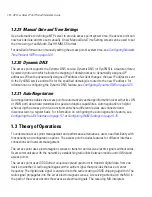
Introduction
1-11
1.2.8.6 WPA2-CCMP (802.11i) Encryption
WPA2 is a newer 802.11i standard that provides even stronger wireless security than
Wi-Fi Protected
Access
(WPA) and WEP.
Counter-mode/CBC-MAC Protocol (CCMP)
is the security standard used by
the
Advanced Encryption Standard (AES).
AES serves the same function TKIP does for WPA-TKIP.
CCMP computes a
Message Integrity Check (MIC)
using the proven
Cipher Block Message
Authentication Code (CBC-MAC)
technique. Changing just one bit in a message produces a totally
different result.
WPA2-CCMP is based on the concept of a
Robust Security Network (RSN),
which defines a hierarchy
of keys with a limited lifetime (similar to TKIP). Like TKIP, the keys the administrator provides are used
to derive other keys. Messages are encrypted using a 128-bit secret key and a 128-bit block of data.
The end result is an encryption scheme as secure as any the provides.
For detailed information on WPA2-CCMP, see
Configuring WPA2-CCMP (802.11i) on page 6-24
.
1.2.8.7 Firewall Security
A firewall keeps personal data in and hackers out. The firewall prevents suspicious Internet traffic
from proliferating the access point managed network. The access point performs
network address
translation
(NAT) on packets passing to and from the WAN port. This combination provides enhanced
security by monitoring communication with the wired network.
For detailed information on configuring the access point’s firewall, see
Configuring Firewall Settings
on page 6-27
.
1.2.8.8 VPN Tunnels
Virtual Private Networks (VPNs)
are IP-based networks using encryption and tunneling providing
users remote access to a secure LAN. In essence, the trust relationship is extended from one LAN
across the public network to another LAN, without sacrificing security. A VPN behaves like a private
network; however, because the data travels through the public network, it needs several layers of
security. The can function as a robust VPN gateway.
For detailed information on configuring VPN security support, see
Configuring VPN Tunnels on page
6-36
.
1.2.8.9 Content Filtering
Content filtering allows system administrators to block specific commands and URL extensions from
going out through the WAN port. Therefore, content filtering affords system administrators selective
control on the content proliferating the network and is a powerful screening tool. Content filtering
Summary of Contents for AP 5131 - Wireless Access Point
Page 1: ...AP 51xx Access Point Product Reference Guide ...
Page 3: ...AP 51xx Access Point Product Reference Guide 72E 103901 01 January 2008 ...
Page 4: ......
Page 44: ...AP 51xx Access Point Product Reference Guide 1 28 ...
Page 76: ...AP 51xx Access Point Product Reference Guide 2 32 ...
Page 92: ...AP 51xx Access Point Product Reference Guide 3 16 ...
Page 588: ...AP 51xx Access Point Product Reference Guide 8 254 ...
Page 610: ...AP 51xx Access Point Product Reference Guide 9 22 3 Define a mesh supported WLAN ...
Page 623: ...Configuring Mesh Networking 9 35 3 Determine the Radio MAC Address and BSSID MAC Addresses ...
Page 653: ...Adaptive AP 10 25 line con 0 line vty 0 24 end ...
Page 654: ...AP 51xx Access Point Product Reference Guide 10 26 ...
Page 666: ...AP 51xx Access Point Product Reference Guide A 12 ...
Page 690: ...AP 51xx Access Point Product Reference Guide C 4 ...
Page 696: ...AP 51xx Access Point Product Reference Guide IN 10 ...
Page 697: ......
















































